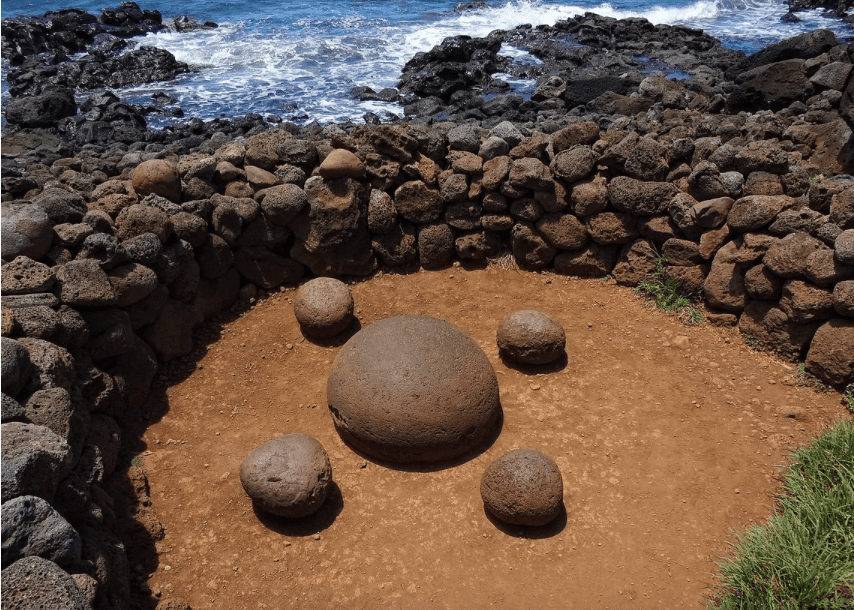John Raffensperger
Fort Meyers, Florida, United States
 |
| Rounded stones near Ahu Te Pito Kura on the north-eastern coast of Easter Island. Thought to symbolize the “center of the world” to the culture of the Polynesian people who first arrived at the island. 2013. Photo by Bjørn Christian Tørrissen. Via Wikimedia. CC BY-SA 3.0 |
In 1999, I traveled from Panama to Easter Island, via the Galapagos, as a passenger/deckhand/ship’s surgeon on an old square-rigged sailing ship. The Norwegian explorer Thor Heyerdahl’s history and description of the island had captured my imagination. Easter Island, the most remote, isolated place on earth, was originally settled by Polynesians who had sailed thousands of miles to find a new home. At first, they thrived, but as their numbers grew they decimated the island’s resources until they were reduced to famine, warfare, and perhaps cannibalism. Easter Island is indeed a “microcosm of our earth.”
I hired a guide to explore and study the giant stone statues, the ancient dwelling places, and a grand volcano. Near the end of the day we came to a lovely sandy beach surrounded by a few palm trees. “This is where the Polynesians first landed,” the guide said, pointing to a rounded dark boulder within a ring of smaller stones near the beach. “It is the navel of the world.” It was warmer than the surrounding stones, and a compass placed on top would not tell north from south. No wonder it had spiritual significance.
The navel of the world reminded me of a patient I had cared for many years before. He was about ten years old, and by a quirk of embryology had an infected cyst in his umbilicus. A remnant of bladder tissue had caused the cyst. It was necessary to remove his umbilicus along with the cyst. A few weeks later, the boy arrived in the clinic with his father. This was unusual because at the county hospital we rarely saw the fathers of our patients. “You took his navel away,” the father said. The boy hopped up onto the examining table and took down his pants. There was a thin transverse scar where I had, indeed, removed his navel along with the cyst. I tried to explain why it was necessary to remove the boy’s umbilicus to the father. After a moment’s reflection he said, “Can you make a new one?”
At first, the request for another operation seemed rather ridiculous, but then I realized the importance of an umbilicus. It was our original connection to our mothers by way of the umbilical cord. After birth, it is the north star of the abdomen, our center, and how we relate up from down and right from left.
Normally, the umbilical cord dries and drops off after a few days, leaving a nice crater in the middle of the abdomen. If the tissues do not close properly, a hernia may form at the umbilicus. These hernias usually spontaneously close by one year of age but may reappear during pregnancy. In Africa, an umbilical hernia is sometimes considered a symbol of fertility.
Mothers often request surgical repair of their umbilical hernias and are disappointed when told that an operation is not necessary because the hernia will cause no trouble and will spontaneously disappear. Normally we did not operate on an umbilical hernia unless it became very large. When we did operate, we took great care to tuck in skin flaps, so the child had an “innie” that looked like a normal umbilicus. Dr. Willis Potts, the former surgeon in chief of the Children’s Memorial Hospital, would respond to the mother’s request for an operation by strapping a coin over the umbilicus with adhesive tape.
I re-admitted the boy to the hospital and, with great care, made two flaps of skin, which I tucked in so as to create a normal appearing umbilicus in the exact center of his old scar. It was a simple, cosmetic operation, but the boy and his family were happier than any of my other patients or families.
JOHN RAFFENSPERGER, MD, graduated from the University of Illinois College of Medicine in 1953, interned at the Cook County Hospital, spent two years in the Navy and returned to Cook County for training in general, thoracic, and pediatric surgery. He was on the attending staff at Cook County until 1970, when he went to the Children’s Memorial Hospital and eventually became the surgeon in chief. He has written textbooks, works of medical history, and novels. After retiring from active practice, he sailed across the Atlantic and back, then served as a voluntary pediatric surgeon at Cook County.

Leave a Reply